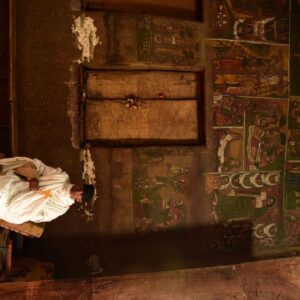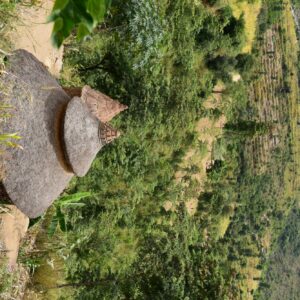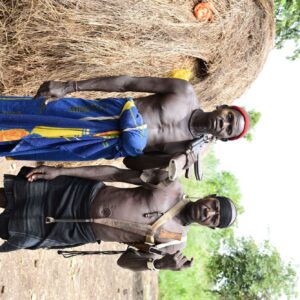My interest in Ethiopia first started when I saw a short documentary on the churches of Lalibela. These Catholic churches were originally carved out of single underground rocks in the 13th century. For most of my childhood in the early 90’s Ethiopia was synonymous with poverty, war, and famine and as I grew older, I usually associated it with Islam.

One day I learned, however, that they were constructing those churches at the same time that Europe was constructing many of the cathedrals that I had so frequently toured in summers with my grandparents, and I was astonished.
My decade and a half of Catholic schooling had not even taught me that Ethiopia had its own branch of Catholicism, the Ethiopian Coptic Church.
Lalibela was, at one point known as the “New Jerusalem.” Their art, too, fascinated me. Many of their murals were drawn in a style similar to those of Greek Orthodox churches, but for the first time in my years of church-visiting the faces framed in halos were wide eyed and brown skinned. Such a new take on Catholicism piqued my interest.
Years later I wrote my Masters in English thesis on the French poet Arthur Rimbaud, who spent about half his life living in the Ethiopian city of Harar. As I wrote and researched, I also looked up the city streets that he had once called home. Harar, which is not too far from the Somali border, is mostly Muslim. Its most important tourist attraction for westerners these days (aside from the Rimbaud museum, obviously!) is a man who hand-feeds hyenas within the city walls. If he likes you, I’m told, he will also let you feed them.
A few summers ago, I finally flew to Ethiopia. Ironically, neither Lalibela nor Harar was on my itinerary. I didn’t have a lot of time and I was meeting a friend. He wanted to hike the Simien mountains. I had not even heard of the Simien mountains and so it just became another interesting facet of Ethiopia that never made its way into Sally Struthers’s “save the children of Ethiopia” commercials. When we got there, I was astonished by what I can best describe as Ireland-meets-the-Grand Canyon. The mountains were a lush green and there was always a little rain.
After our trek, we headed south to visit some of the many tribes that still call the Omo river valley home, living the way they have for hundreds, if not thousands of years.
Recently, Ethiopia has seen some unfortunate violence as a result of tensions between some of its many ethnic groups; the most horrific being the massacre of 54 people in a schoolyard. As tensions rise in Ethiopia, it’s hard not to make parallels to our own country. Just recently, in anticipation of Election Day, I found myself stuck behind a caravan of large trucks flying Trump flags the size of bedsheets. Many of the buildings in my neighborhood looked more ready for a hurricane than an election as the owners had boarded their windows in anticipation of escalating tensions due to what were the imminent election results. Fortunately, now that we have the election results we have not seen any of the anticipated civil unrest, but the President-Elect Biden will be given a country with growing friction between many groups, not unlike Ethiopia.

It’s easy for us to look at a country like Ethiopia and see just how different its people are. Some of its citizens live high in the mountains and pray the “Our Father” before their morning coffee, while others kneel on rugs in Mosques, and still others wear animal skins and carry spears while migrating after animal herds. So much of the nation is modernizing at a rapid rate while still trying to hold on to its very old roots.
Americans might not think of themselves as anything like Ethiopia, but we are. We have our indigenous tribes, we have Wall Street bankers and West Virginia coal miners, Jews, Catholics, Muslims, Protestants, atheists, gun lovers and gun haters, soldiers and school teachers, progressives and conservatives, first generation, second, third, immigrants, English-speakers, and non-English speakers. And let’s not forget that America, too, is no stranger to schoolyard massacres.

From the outside, Ethiopia might seem like a wild and unfortunate place, but travel there and you might feel differently. One night, after a day of visiting some tribes deep in the bush, I was invited to a birthday party of someone who lived in the nearby city. The adults barbequed while kids rode their bikes and chased each other in the yard. We listened to music, drank beer, and danced. Later that night I found myself sharing a few more beers amidst stories with locals at a bar, and then dancing in a club and taking selfies with strangers outside. It was an all too familiar scene.
When you begin to understand a country like Ethiopia you too might find so much is familiar. And when you look back at America you will see it with new perspective. You will see a country with so many diverse identities, so many tribes. Some of those tribes hold onto spears, some onto guns, some clutch crosses, and some kneel, some hold checkbooks, while others hold donation boxes but all of them hold on tightly.












